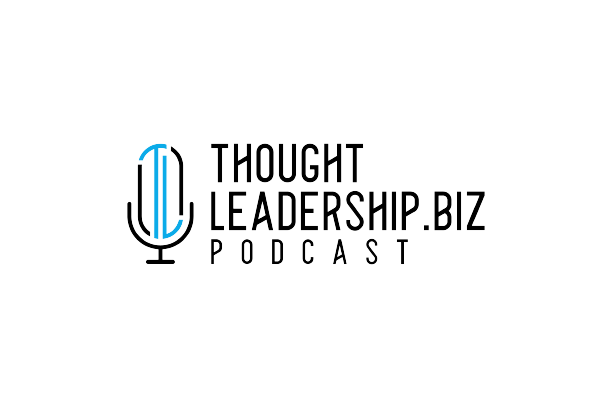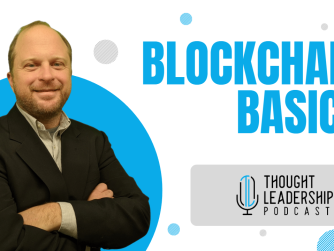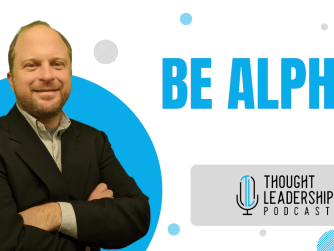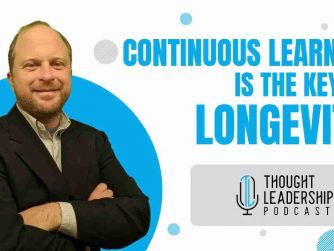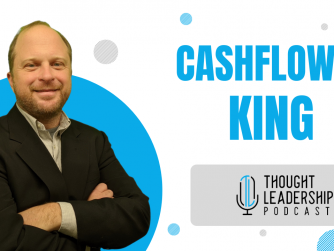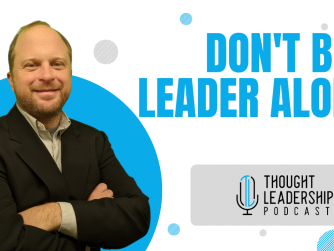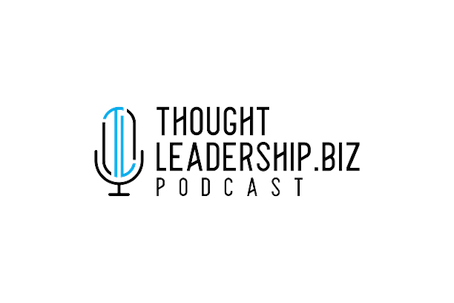
Read / Watch / Listen
Stream this article from your favorite podcast audio or video streaming service as referenced below.
Read: Below
Watch: https://youtu.be/td3rKgkjX5s
Listen: https://anchor.fm/thoughtleadershipbiz
More ways to read, watch and listen
Hi everyone, and welcome to another engrossing episode of ThoughtLeadership.biz with me, Chris Machut. And today, folks, I’m in a good mood for two very good reasons: One, it’s our second season anniversary! And two, because we’re talking about. . . happiness! And yes, unbridled business bliss CAN exist in the business world, if you believe Ben Shahar and Megan McDonough, co-founders of the Wholebeing Institute.
*****
But before we get stuck into the nitty gritty, let’s take a moment to think about what happiness in the wider context actually is, because it means different things to different people.
When researching this article, I figured the most sensible place to find a good definition for happiness was the dictionary. But it seems I was wrong. Here’s the dictionary.com definition I found: The quality or state of being happy. Gee, thanks. That’s the equivalent of saying that the definition for orange juice is juice that’s in a state of being orange.
However, at the risk of sounding like a Zen master from a cheesy 80’s kung-fu movie, it’s true to say that the lack of a definition is a definition in itself. In other words: Happiness is subjective.
How do you define yours?
For me, happiness means kicking back on my sofa with a beer and a couple of buddies, feet up and the football on (Just a wild stab in the dark – am I stereotyping here? ), creating amazing content and connecting with amazing people for
ThoughtLeadership.biz, or watching cheesy 80s kung-fu movies with suitably poor dubbing and ridiculously fake facial hair. . . But that’s just me.
*****
The questions we’re asking today are: How can we be happier in life and business? And: How can we help colleagues be happier, too? To answer those questions, we apparently need look no further than ‘SPIRE’, the happiness strategy created by Ben Shahar and Megan McDonough, co-founders of Wholebeing Institute.
They suggest that business bliss begins with the breath – and no, they’re not talking about introducing Buddhist meditation into the boardroom. Instead, they explain that the word ‘spire’ can found within the word ‘respire,’ meaning to breathe – the act that keeps you alive. That sounds like a reasonable starting point, as it’s generally accepted that it’s difficult to be happy if you’re dead. And being dead isn’t good for business either.
Apparently, the acronym SPIRE represents five parts of the “whole being”: Spiritual, Physical, Intellectual, Relational and Emotional and the approach taught encourages you to ‘know yourself better and understand and value that which is uniquely and wonderfully you.’
Hmmm. . . Sounds a little more like the back page blurb from a retreat centre brochure rather than a strategy for increasing happiness a business setting, but let’s continue. . .
Ben and Megan explain that: ‘When you become grounded in who you are, it becomes a source of energy. While respiring (breathing) keeps you alive, SPIRE well-being seeks to keep you enlivened.’ Alrighty, so there you have it. The secret to happiness is know yourself better, be grounded in who you are and then surf that enlivened energy all the way to the bank and beyond.
Sounds good to me. But how do we actually do it? And how do we then teach others to do the same? Because business is a team effort, right?
*****
Before we go there, I’d better remind you about a few quick ways that’ll bring a little more business bliss into your life right now! So, be sure to check out my newest articles, podcasts and more at ThoughtLeadership.biz. If that’s not enough, you can also catch me in person on YouTube or listen to my regular rants via Spotify and Anchor as well as Apple and Google Podcasts. I also shamelessly promote myself on Twitter and LinkedIn, where you can subscribe for notifications. . .
*****
Okay, so now we’ve got an overview of what SPIRE is supposed to do, let’s delve a little deeper and have a look at the nuts and bolts of this ‘philosophy of living’.
Rather than just focussing on one or two of the SPIRE dimensions, the focus is put on living in all five, all the time, as they’re interconnected. It’s that completeness, or ‘wholeness’, that produces what the founders call ‘the enviable state of whole-person well-being’ and enables nurture, growth, inspiration, and pleasure – in other words: Happiness.
The first dimension is Spiritual:
This dimension is concerned with the personal and experiential side of things. It’s focused on finding a sense of purpose in life and explores the question: What’s the meaning of life? Or, if that’s too much to chew on: What does life mean to me? The Spiritual dimension is non-religious and asks us to be mindful of life experiences, connect with them and appreciate them, and in doing make sense of them and make them more meaningful.
The second dimension is Physical:
Now, if you’re anything like me, physical exercise isn’t exactly top of the agenda. But that’s one of the things that needs to change right away if you’re serious about SPIRE. The SPIRE approach encourages us to rethink how we eat, sleep and exercise, as the mind and body are closely connected.
Activities like yoga are recommended (but not necessarily in the office during office hours) because they help to activate the parasympathetic nervous system, which is responsible for regulating our unconscious actions. Apparently, an incredible 95 percent or more of our daily life is controlled by our subconscious, which means we’re basically zombies for most of the day. Which, I guess, does explain a few things. . .
So, in a nutshell: getting active helps increase happiness.
Dimension three is Intellectual:
According to the SPIRE model, nurturing our creative energies and engaging in meaningful learning activities is a great way to increase wellbeing.
We’re encouraged to take more of an interest in the world around us and ‘captivate our curiosity by engaging with literature and the arts, which are excellent ways to increase our intellectual capacity. I guess we could call ThoughtLeadership.biz literature, of a sort, right? This means that by reading my articles and listening to videos you’re actually increasing your grey matter, connecting with your ‘wholebeing’, and supercharging your chances for happiness. Now that’s what I call a public service!
So, now that we’ve nailed the first three dimensions and got the good vibes flowing, it’s selfish not to share them about, which is why SPIRE’s fourth dimension focuses on the Relational:
This dimension is all about the community. It’s all about creating a harmonious, symbiotic web of relationships with family, friends, and even complete strangers (within reason, I guess; be careful of those zombies, right?).
The basic idea is that we should actively aim to engage with other people and have meaningful exchanges with them as frequently as we can. In the office, that could mean having a quick chat at the water fountain with a co-worker you’ve not spoken to before, or perhaps a word of thanks to the cleaner. I’m sure you get the idea.
The idea of meaningful micro-exchanges – pleasantries and polite, engaged small talk – are important elements of the human experience and potentially enriching ones, too. There are so many chances every day to connect better with the people around us, but in this increasingly hectic and demanding world – especially in the business world – we often miss them.
The fifth and final dimension is Emotional:
This dimension is related to our emotional balance; our sense of harmony and equilibrium within ourselves. That sense of emotional stability is what centers us and our relationships with others. It’s also the foundation for resilience, which is something that we all need in our everyday life and in our work, especially as business leaders.
Having a great IQ is, well… great. But it’s not enough by itself.
After all, there are plenty of examples of uber-intelligent, ‘successful’ business people who are complete shmucks and whose entire company (and family, probably) hates them. Are they powerful? Sure. Rich? You bet. Happy? I doubt it.
No matter how you define great leadership, the EQ – the Emotional Quotient – is fundamental to it. The ability to understand yourself as well as empathize with those around you means that you are much better prepared to build a network of meaningful relationships in your personal and professional spheres. As a result, you have a higher chance of being happy and your business has a far higher chance of ongoing success.
But creating that personal ‘whole being’ happiness and professional success requires more than simply understanding the SPIRE concepts in your brain. You have to actually live them. All of them. All of the time. And that’s obviously easier said than done.
*****
So, we’ve covered the first question: How can we be happier in life and business? The answer is: Give SPIRE a try. But what about the second one: How can we help colleagues be happier, too? Well, the answer is simple: Lead by example. After all, that’s what good leaders do, right?
On that note, I’ll finish off with one of the undisputed heavyweights of outstanding leadership, Abraham Lincoln. It might seem strange to end this article with the words of a dead president, given the fact that SPIRE is inspired by the idea of life-giving breath, but good old Abe was a wise man indeed.
He once said:
“Folks are usually about as happy as they make their minds up to be.”
And I reckon he was just about right with that. Whether or not YOU are inspired to give the SPIRE method a go is a personal thing; it’s entirely up to you. Personally, I doubt it’s the only key to creating business bliss, but it’s probably something worth trying. Who knows what’s waiting behind The Door To Happiness?
An acrobatic old man in golden pajamas, probably.
This is Chris Machut.
See you next time – and don’t forget to breathe out there!
Latest posts by ThoughtLeadership (see all)
- Episode 24 – The Crypto Cake CEX vs DEX - January 27, 2023
- Episode 23 – Blockchain Basics - December 16, 2022
- Episode 22 – Be Alpha - November 18, 2022


